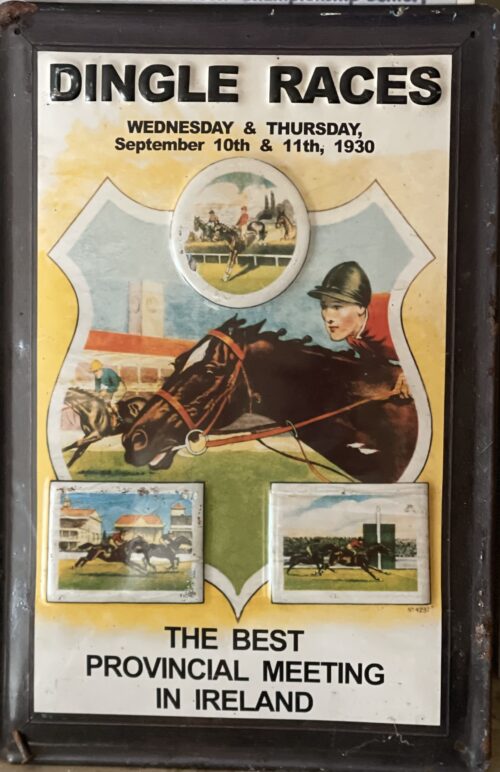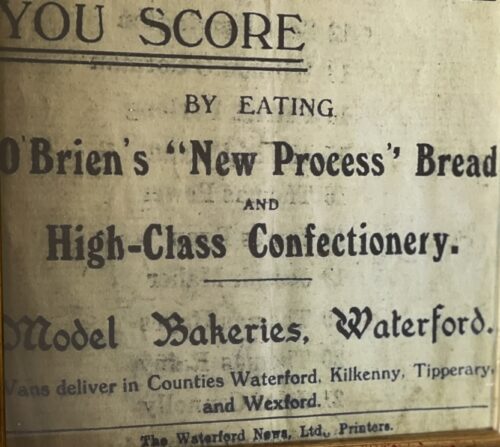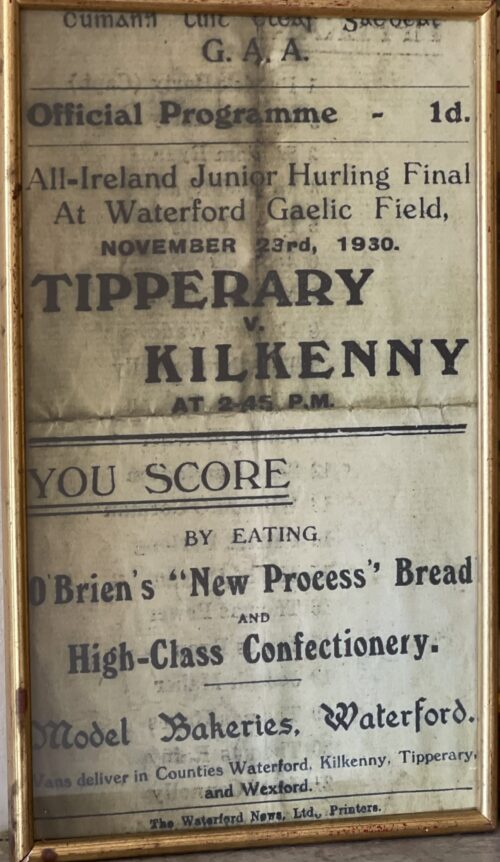38cm x 115cm
A wonderful b&w photograph of the old Croke Park and of both teams standing to attention for the customary recital of the National Anthem, when Kerry and Galway met in the All Ireland Football Final Replay.The first game ended in a draw before Galway went on to win the replay a few weeks later.The attendance was officially 68,950 with little or no need for crowd control.This magnificent panoramic view is a poignant sporting snapshot of former times and again makes a beautiful addition to the collection of anyone interested in bygone times.

The 1938 All-Ireland Football Final Replay on October 23rd, 1938 ended in the most bizarre fashion imaginable when with 2 minutes left to play, Galway supporters, mistakenly believing the referee had blown for full-time, invaded the pitch, causing a 20 minute delay before the final minutes could be played out.
Even more dramatic was the fact that by the time the pitch was cleared, most of the Kerry players seemed to have disappeared.

The confusion all began with a free awarded to Kerry by referee Peter Waters of Kildare with Galway leading the defending champions, by 2-4 to 0-6.
The referee placed the ball and blew his whistle for the kick to be taken while running towards the Galway goals. He looked round just as Sean Brosnan was taking the kick and seeing a Galway player too close he blew for the kick to be retaken.
Thinking that he had blown for full-time the jubilant Galway supporters invaded the pitch.

It took all of twenty minutes to clear the pitch but only then did the real problems come to light. Jerry O’Leary Chairman of the Kerry Selection Committee outlined their dilemma.


Somehow or other Kerry managed to re-field even if the team which played out the remaining minutes bore little resemblance to the starting fifteen.

More remarkable again was the fact that Kerry went on to add another point to their total before the referee finally blew for full-time with Galway winners by 2-4 to 0-7.
It was generally agreed that the confusion was of the crowd’s and not the referee’s making but questions remained about the total number of players Kerry had been permitted to use in those final few minutes.

The National and Provincial papers and indeed all available Records to this day list only those 16 Kerry players who were involved prior to the 20 minute interruption but now (80 years on) for the first time all the players who played for Kerry in that October 23rd, 1938 All-Ireland Final Replay can be given their rightful place in the Record Books.
KERRY’s 24:
- Dan O’Keeffe (Tralee O’Rahilly’s)
- Bill Kinnerk (Tralee, Boherbee John Mitchel’s)(Captain)
- Paddy ‘Bawn’ Brosnan (Dingle)
- Bill Myers (Killarney)
- Bill Dillon Dingle)
- Bill Casey (Dingle)
- Tom ‘Gega’ O’Connor (Dingle)
- Sean Brosnan (Dingle)
- Johnny Walsh (Ballylongford, North Kerry)
- Paddy Kennedy (Tralee O’Rahilly’s)(Annascaul native)
- Charlie O’Sullivan (Tralee O’Rahilly’s)(Camp native)
- Tony McAuliffe (Listowel, North Kerry)
- Martin Regan (Tralee Rock Street Austin Stacks)
- Michael ‘Miko’ Doyle ((Tralee Rock Street Austin Stacks)
- Timmy O’Leary (Killarney).
- J.J. ‘Purty’ Landers (Tralee Rock Street Austin Stacks)(brother of Tim and Bill)(replaced Johnny Walsh – injured hip and dislocated collarbone)
- Joe Keohane (Geraldines, Dublin)(former Tralee Boherbee John Mitchel’s player)
- Michael ‘Murt’ Kelly (Geraldine’s, Dublin)(formerly Tralee O’Rahilly’s)
- J.Sheehy (Tralee Boherbee John Mitchel’s)
- Eddie Walsh (Knocknagoshel, North Kerry)
- Ger Teahan (Laune Rangers, Killorglin)
- Bob Murphy (Newtown, North Kerry)
- Con Gainey (Tralee Boherbee John Mitchel’s)(Castleisland native)
- M. Raymond (Tralee O’Rahilly’s)
So in total and in contravention of the Rules Kerry used 24 players including 9 substitutes. Galway in contrast used a mere 17 players including 2 substitutes.
GALWAY’S 17:
- Jimmy McGauran (University College Galway)(Roscommon native)
- Mick Raftery (University College Galway)(Mayo native)
- Mick Connaire (Beann Éadair, Dublin)(Ballinasloe native)
- Dinny Sullivan (Oughterard)
- Frank Cunniffe (Beann Éadair, Dublin)(Ballinasloe native)
- Bobby Beggs (Wolfe Tones, Galway City)(Dublin native)(former Skerries Harps player)
- Charlie Connolly (Ballinasloe Mental Hospital)
- John ‘Tull’ Dunne (Ballinasloe St. Grellan’s)(Captain)
- John Burke (Remore)(Clare native)
- Jackie Flavin (Wolfe Tones, Galway City)(Kerry native – Newtownsandes)(won 1937 All-Ireland with Kerry)
- Ralph Griffin (Ballinasloe St. Grellan’s)
- Mick Higgins (Wolfe Tones, Galway City)
- Ned Mulholland (Wolfe Tones, Galway City)(Westmeath native)
- Martin Kelly (Ardagh, Limerick)(Ahascragh native)
- Brendan Nestor (Geraldines, Dublin)(Dunmore native)
- Mick Ryder (Tuam Stars)
- Pat McDonagh
It was almost as if Galway had won the All-Ireland twice in one day beating two different Kerry teams in the process.


That night, in front of a 1,500 crowd, at a Gaelic League organised Siamsa Mór in the Mansion House in Dawson Street, Art McCann presented the Galway team with their winners’ medals.

The Kerry players meanwhile joined 300 of their suppoeters at a Ceilidhe hosted by the Kerrymen’s Social Club in Rathmines Town Hall.
The National Newspapers may not always have reported the facts to Galway’s satisfaction but there can be no questioning the support of Galway County Council.

Needless to say the Galway players received an unprecedented welcome on their return to Galway having first been feted along the way in Mullingar, Streamstown, Moate and Athlone.
GALWAY – 1938 ALL-IRELAND SENIOR FOOTBALL CHAMPIONS

Back (L-R) Bobby Beggs, Ralph Griffin, John Burke, Jimmy McGauran, Charlie Connolly, Brendan Nestor, Dinny Sullivan, Mick Connaire, Martin Kelly. Front (L-R) Frank Cunniffe, Jackie Flavin, Mick Higgins, John ‘Tull’ Dunne (Capt), Ned Mulholland, Mick Raftery.
Substitutes: (not in photograph) Mick Ryder and Pat McDonagh.
TIME ADDED ON:
Not far behind the controversy surrounding the last few minutes of 1938 All-Ireland Football Final Replay was the controversy surrounding the last few seconds of the drawn match played a month earlier.


The sides were level, Kerry 2-06 Galway 3-03, when Kerry’s J.J. Landers sent the ball between the Galway uprights for what looked like the winning point. However the thousands of celebrating Kerry supporters making for the Croke Park exits were soon stopped in their tracks.

It was cruel luck on Kerry and while there were many who criticised the referee, Tom Culhane from Glin, County Limerick, for blowing the final whistle while John Joe Landers was it the act of shooting, Kerry’s County Board Chairman Denis J. Bailey wasn’t among them.
At the next Central Council meeting, in a remarkably generous response to the Referee’s Report being read he stated that ‘they in Kerry were quite satisfied with the result’ and ‘They wished to pay a tribute to Galway for their sporting spirit and also to the referee who, in their opinion, carried out his duties very well.’
The Central Council then awarded the two counties £300 each towards the costs of the two-week Collective Training Camps both counties had planned in the lead up to the Replay on October 23rd. Munster Council granted Kerry (pictured here in Collective Training) an additional £100.

Prior to that Central Council meeting, General Secretary, Pádraig Ó’Caoimh, received a telephone call from the New York GAA suggesting the replay take place in New York but the request (which was successfully repeated nine years later in 1947) was on this occasion turned down.
However doubts about the Replay even going ahead were immediately raised.

Satisfactory transport arrangements were eventually agreed and the match went ahead although the Kerry supporters who left Tralee on the so-called ‘ghost’ train at 1am on the morning of the October 23rd may still have felt hard done by.

In the lead-up to the game the Galway selectors expressed their delight at the success of their forwards short hand-passing game against the Kerry backs in the drawn match although there were some worries that not all their players had been able to attend the first week of Collective Training and of course there was Kerry’s Replay record to be considered.
Kerry had previously played in 4 All-Ireland Replays and won them all, a great source of encouragement to the Kerry supporters.
However amid some reports of disharmony within the Kerry camp, following a ‘trial match’ on the Sunday before the Replay, the Kerry selection Committee dropped a real bombshell.
Joe Keohane (Dublin Geraldines) who had been Kerry’s regular full-back for the previous two years and was one of the stars of their 1937 All-Ireland win over Cavan was replaced by young Paddy ‘Bawn’ Brosnan a member of the 1938 Kerry Junior team.
A back injury to Kerry’s best forward, J.J. Landers made him an extreme doubt for the Replay with Martin Regan on stand-by to take his place if required which is exactly what happened before that fateful free-kick, that infamous 20 minute delay and Kerry’s unprecedented use of 24 players.
Most definitely an All-Ireland Final and Final Replay never to be forgotten.

The Galway and Kerry players parade in front of the newly opened (1938) Cusack Stand
Croke Park (
Irish:
Páirc an Chrócaigh) is a
Gaelic games stadium located in
Dublin, Ireland. Named after Archbishop
Thomas Croke, it is sometimes called
Croker by GAA fans and locals.
It serves as both the principal stadium and headquarters of the
Gaelic Athletic Association (GAA). Since 1891
the site has been used by the GAA to host Gaelic sports, including the annual All-Ireland in
Gaelic football and
hurling.
A major
expansion and redevelopment of the stadium ran from 1991–2005, raising capacity to its current 82,300 spectators.
This makes Croke Park the
third-largest stadium in Europe, and the largest not usually used for
association football.
Other events held at the stadium include the opening and closing ceremonies of the
2003 Special Olympics, and numerous musical concerts. In 2012, Irish pop group
Westlife sold out the stadium in record-breaking time: less than 5 minutes. From 2007–10, Croke Park hosted home matches of the
Ireland national rugby union team and the
Republic of Ireland national football team, while their new
Aviva Stadium was constructed. This use of Croke Park for non-Gaelic sports
was controversial and required temporary changes to GAA rules. In June 2012, the stadium hosted the closing ceremony of the
50th International Eucharistic Congress during which
Pope Benedict XVI gave an address over video link.
City and Suburban Racecourse

A fireworks and light display was held in Croke Park in front of 79,161 fans on Saturday 31 January 2009 to mark the GAA's 125th anniversary
The area now known as Croke Park was owned in the 1880s by Maurice Butterly and known as the City and Suburban Racecourse, or Jones' Road sports ground. From 1890 it was also used by the
Bohemian Football Club. In 1901 Jones' Road hosted the
IFA Cup football final when
Cliftonville defeated
Freebooters.
History
Recognising the potential of the Jones' Road sports ground a journalist and GAA member, Frank Dineen, borrowed much of the £3,250 asking price and bought the ground in 1908. In 1913 the GAA came into exclusive ownership of the plot when they purchased it from Dineen for £3,500. The ground was then renamed Croke Park in honour of Archbishop
Thomas Croke, one of the GAA's first patrons.
In 1913, Croke Park had only two stands on what is now known as the Hogan stand side and grassy banks all round. In 1917, a grassy hill was constructed on the railway end of Croke Park to afford patrons a better view of the pitch. This terrace was known originally as Hill 60, later renamed Hill 16 in memory of the 1916
Easter Rising. It is erroneously believed to have been built from the ruins of the GPO, when it was constructed the previous year in 1915.
In the 1920s, the GAA set out to create a high capacity stadium at Croke Park. Following the Hogan Stand, the Cusack Stand, named after
Michael Cusack from Clare (who founded the GAA and served as its first secretary), was built in 1927. 1936 saw the first double-deck Cusack Stand open with 5,000 seats, and concrete terracing being constructed on Hill 16. In 1952 the Nally Stand was built in memorial of
Pat Nally, another of the GAA founders. Seven years later, to celebrate the 75th anniversary of the GAA, the first cantilevered "New Hogan Stand" was opened.
The highest attendance ever recorded at an All-Ireland Senior Football Championship Final was 90,556 for
Offaly v
Down in
1961. Since the introduction of seating to the Cusack stand in 1966, the largest crowd recorded has been 84,516.
Bloody Sunday

Bloody Sunday remembrance plaque
During the
Irish War of Independence on 21 November 1920 Croke Park was the scene of a massacre by the
Royal Irish Constabulary (RIC). The Police, supported by the
British Auxiliary Division, entered the ground and began shooting into the crowd, killing or fatally wounding 14 civilians during a
Dublin-
Tipperary Gaelic football match. The dead included 13 spectators and Tipperary player
Michael Hogan. Posthumously, the Hogan stand built in 1924 was named in his honour. These shootings, on the day which became known as
Bloody Sunday, were a reprisal for the killing of 15 people associated with the
Cairo Gang, a group of
British Intelligence officers, by
Michael Collins' '
squad' earlier that day.
Dublin Rodeo
In 1924, American
rodeo promoter,
Tex Austin, staged the Dublin Rodeo,
Ireland's first professional rodeo at Croke Park Stadium.
For seven days, with two shows each day from August 18 to August 24, sell out crowds saw cowboys and cowgirls from Canada, the United States, Mexico, Argentina and Australia compete for rodeo championship titles.
Canadian bronc riders such as Andy Lund and his brother Art Lund, trick riders such as Ted Elder
and Vera McGinnis were among the contestants.
British Pathe filmed some of the rodeo events.
Stadium design
In 1984 the organisation decided to investigate ways to increase the capacity of the old stadium. The design for an 80,000 capacity stadium was completed in 1991. Gaelic sports have special requirements as they take place on a large field. A specific requirement was to ensure the spectators were not too far from the field of play. This resulted in the three-tier design from which viewing games is possible: the main concourse, a premium level incorporating hospitality facilities and an upper concourse. The premium level contains restaurants, bars and conference areas. The project was split into four phases over a 14-year period. Such was the importance of Croke Park to the GAA for hosting big games, the stadium did not close during redevelopment. During each phase different parts of the ground were redeveloped, while leaving the rest of the stadium open. Big games, including the annual All-Ireland Hurling and Football finals, were played in the stadium throughout the development.
The outside of the Cusack Stand
Phase one – New Cusack Stand
The first phase of construction was to build a replacement for Croke Park's Cusack Stand. A lower deck opened for use in 1994. The upper deck opened in 1995. Completed at a cost of £35 million, the new stand is 180 metres long, 35 metres high, has a capacity for 27,000 people and contains 46 hospitality suites. The new Cusack Stand contains three tiers from which viewing games is possible: the main concourse, a premium level incorporating hospitality facilities and finally an upper concourse. One end of the pitch was closer to the stand after this phase, as the process of slightly re-aligning the pitch during the redevelopment of the stadium began. The works were carried out by
Sisk Group.
Phase two – Davin Stand
Phase Two of the development started in late 1998 and involved extending the new Cusack Stand to replace the existing Canal End terrace. It involved reacquiring a rugby pitch that had been sold to
Belvedere College in 1910 by Frank Dineen. In payment and part exchange, the college was given the nearby Distillery Road sportsgrounds.
[19]
It is now known as The Davin Stand (Irish:
Ardán Dáimhím), after
Maurice Davin, the first president of the GAA. This phase also saw the creation of a tunnel which was later named the Ali tunnel in honour of
Muhammad Ali and
his fight against Al Lewis in July 1972 in Croke Park.
Phase three – Hogan Stand
Phase Three saw the building of the new Hogan Stand. This required a greater variety of spectator categories to be accommodated including general spectators, corporate patrons, VIPs, broadcast and media services and operation staff. Extras included a fitted-out mezzanine level for VIP and Ard Comhairle (Where the dignitaries sit) along with a top-level press media facility. The end of Phase Three took the total spectator capacity of Croke Park to 82,000.
Phase four – Nally Stand & Nally End/Dineen Hill 16 terrace
After the 2003 Special Olympics, construction began in September 2003 on the final phase, Phase Four. This involved the redevelopment of the Nally Stand, named after the athlete
Pat Nally, and Hill 16 into a new Nally End/Dineen Hill 16 terrace. While the name Nally had been used for the stand it replaced, the use of the name Dineen was new, and was in honour of
Frank Dineen, who bought the original stadium for the GAA in 1908, giving it to them in 1913. The old Nally Stand was taken away and reassembled in Pairc Colmcille, home of Carrickmore GAA in
County Tyrone.
The phase four development was officially opened by the then GAA President
Seán Kelly on 14 March 2005. For logistical reasons (and, to a degree, historical reasons), and also to provide cheaper high-capacity space, the area is a terrace rather than a seated stand, the only remaining standing-room in Croke Park. Unlike the previous Hill, the new terrace was divided into separate sections – Hill A (Cusack stand side), Hill B (behind the goals) and the Nally terrace (on the site of the old Nally Stand). The fully redeveloped Hill has a capacity of around 13,200, bringing the overall capacity of the stadium to 82,300. This made the stadium the second biggest in the EU after the
Camp Nou, Barcelona. However, London's new Wembley stadium has since overtaken Croke Park in second place. The presence of terracing meant that for the brief period when Croke Park hosted international
association football during 2007–2009, the capacity was reduced to approximately 73,500, due to FIFA's statutes stating that competitive games must be played in all-seater stadiums.
Pitch
 The 1938 All-Ireland Football Final Replay on October 23rd, 1938 ended in the most bizarre fashion imaginable when with 2 minutes left to play, Galway supporters, mistakenly believing the referee had blown for full-time, invaded the pitch, causing a 20 minute delay before the final minutes could be played out.
Even more dramatic was the fact that by the time the pitch was cleared, most of the Kerry players seemed to have disappeared.
The 1938 All-Ireland Football Final Replay on October 23rd, 1938 ended in the most bizarre fashion imaginable when with 2 minutes left to play, Galway supporters, mistakenly believing the referee had blown for full-time, invaded the pitch, causing a 20 minute delay before the final minutes could be played out.
Even more dramatic was the fact that by the time the pitch was cleared, most of the Kerry players seemed to have disappeared.
 The confusion all began with a free awarded to Kerry by referee Peter Waters of Kildare with Galway leading the defending champions, by 2-4 to 0-6.
The referee placed the ball and blew his whistle for the kick to be taken while running towards the Galway goals. He looked round just as Sean Brosnan was taking the kick and seeing a Galway player too close he blew for the kick to be retaken.
Thinking that he had blown for full-time the jubilant Galway supporters invaded the pitch.
The confusion all began with a free awarded to Kerry by referee Peter Waters of Kildare with Galway leading the defending champions, by 2-4 to 0-6.
The referee placed the ball and blew his whistle for the kick to be taken while running towards the Galway goals. He looked round just as Sean Brosnan was taking the kick and seeing a Galway player too close he blew for the kick to be retaken.
Thinking that he had blown for full-time the jubilant Galway supporters invaded the pitch.
 It took all of twenty minutes to clear the pitch but only then did the real problems come to light. Jerry O’Leary Chairman of the Kerry Selection Committee outlined their dilemma.
It took all of twenty minutes to clear the pitch but only then did the real problems come to light. Jerry O’Leary Chairman of the Kerry Selection Committee outlined their dilemma.

 Somehow or other Kerry managed to re-field even if the team which played out the remaining minutes bore little resemblance to the starting fifteen.
Somehow or other Kerry managed to re-field even if the team which played out the remaining minutes bore little resemblance to the starting fifteen.
 More remarkable again was the fact that Kerry went on to add another point to their total before the referee finally blew for full-time with Galway winners by 2-4 to 0-7.
It was generally agreed that the confusion was of the crowd’s and not the referee’s making but questions remained about the total number of players Kerry had been permitted to use in those final few minutes.
More remarkable again was the fact that Kerry went on to add another point to their total before the referee finally blew for full-time with Galway winners by 2-4 to 0-7.
It was generally agreed that the confusion was of the crowd’s and not the referee’s making but questions remained about the total number of players Kerry had been permitted to use in those final few minutes.
 The National and Provincial papers and indeed all available Records to this day list only those 16 Kerry players who were involved prior to the 20 minute interruption but now (80 years on) for the first time all the players who played for Kerry in that October 23rd, 1938 All-Ireland Final Replay can be given their rightful place in the Record Books.
KERRY’s 24:
The National and Provincial papers and indeed all available Records to this day list only those 16 Kerry players who were involved prior to the 20 minute interruption but now (80 years on) for the first time all the players who played for Kerry in that October 23rd, 1938 All-Ireland Final Replay can be given their rightful place in the Record Books.
KERRY’s 24:

 That night, in front of a 1,500 crowd, at a Gaelic League organised Siamsa Mór in the Mansion House in Dawson Street, Art McCann presented the Galway team with their winners’ medals.
That night, in front of a 1,500 crowd, at a Gaelic League organised Siamsa Mór in the Mansion House in Dawson Street, Art McCann presented the Galway team with their winners’ medals.
 The Kerry players meanwhile joined 300 of their suppoeters at a Ceilidhe hosted by the Kerrymen’s Social Club in Rathmines Town Hall.
The National Newspapers may not always have reported the facts to Galway’s satisfaction but there can be no questioning the support of Galway County Council.
The Kerry players meanwhile joined 300 of their suppoeters at a Ceilidhe hosted by the Kerrymen’s Social Club in Rathmines Town Hall.
The National Newspapers may not always have reported the facts to Galway’s satisfaction but there can be no questioning the support of Galway County Council.
 Needless to say the Galway players received an unprecedented welcome on their return to Galway having first been feted along the way in Mullingar, Streamstown, Moate and Athlone.
GALWAY – 1938 ALL-IRELAND SENIOR FOOTBALL CHAMPIONS
Needless to say the Galway players received an unprecedented welcome on their return to Galway having first been feted along the way in Mullingar, Streamstown, Moate and Athlone.
GALWAY – 1938 ALL-IRELAND SENIOR FOOTBALL CHAMPIONS
 Back (L-R) Bobby Beggs, Ralph Griffin, John Burke, Jimmy McGauran, Charlie Connolly, Brendan Nestor, Dinny Sullivan, Mick Connaire, Martin Kelly. Front (L-R) Frank Cunniffe, Jackie Flavin, Mick Higgins, John ‘Tull’ Dunne (Capt), Ned Mulholland, Mick Raftery.
Substitutes: (not in photograph) Mick Ryder and Pat McDonagh.
TIME ADDED ON:
Not far behind the controversy surrounding the last few minutes of 1938 All-Ireland Football Final Replay was the controversy surrounding the last few seconds of the drawn match played a month earlier.
Back (L-R) Bobby Beggs, Ralph Griffin, John Burke, Jimmy McGauran, Charlie Connolly, Brendan Nestor, Dinny Sullivan, Mick Connaire, Martin Kelly. Front (L-R) Frank Cunniffe, Jackie Flavin, Mick Higgins, John ‘Tull’ Dunne (Capt), Ned Mulholland, Mick Raftery.
Substitutes: (not in photograph) Mick Ryder and Pat McDonagh.
TIME ADDED ON:
Not far behind the controversy surrounding the last few minutes of 1938 All-Ireland Football Final Replay was the controversy surrounding the last few seconds of the drawn match played a month earlier.

 The sides were level, Kerry 2-06 Galway 3-03, when Kerry’s J.J. Landers sent the ball between the Galway uprights for what looked like the winning point. However the thousands of celebrating Kerry supporters making for the Croke Park exits were soon stopped in their tracks.
The sides were level, Kerry 2-06 Galway 3-03, when Kerry’s J.J. Landers sent the ball between the Galway uprights for what looked like the winning point. However the thousands of celebrating Kerry supporters making for the Croke Park exits were soon stopped in their tracks.
 It was cruel luck on Kerry and while there were many who criticised the referee, Tom Culhane from Glin, County Limerick, for blowing the final whistle while John Joe Landers was it the act of shooting, Kerry’s County Board Chairman Denis J. Bailey wasn’t among them.
At the next Central Council meeting, in a remarkably generous response to the Referee’s Report being read he stated that ‘they in Kerry were quite satisfied with the result’ and ‘They wished to pay a tribute to Galway for their sporting spirit and also to the referee who, in their opinion, carried out his duties very well.’
The Central Council then awarded the two counties £300 each towards the costs of the two-week Collective Training Camps both counties had planned in the lead up to the Replay on October 23rd. Munster Council granted Kerry (pictured here in Collective Training) an additional £100.
It was cruel luck on Kerry and while there were many who criticised the referee, Tom Culhane from Glin, County Limerick, for blowing the final whistle while John Joe Landers was it the act of shooting, Kerry’s County Board Chairman Denis J. Bailey wasn’t among them.
At the next Central Council meeting, in a remarkably generous response to the Referee’s Report being read he stated that ‘they in Kerry were quite satisfied with the result’ and ‘They wished to pay a tribute to Galway for their sporting spirit and also to the referee who, in their opinion, carried out his duties very well.’
The Central Council then awarded the two counties £300 each towards the costs of the two-week Collective Training Camps both counties had planned in the lead up to the Replay on October 23rd. Munster Council granted Kerry (pictured here in Collective Training) an additional £100.
 Prior to that Central Council meeting, General Secretary, Pádraig Ó’Caoimh, received a telephone call from the New York GAA suggesting the replay take place in New York but the request (which was successfully repeated nine years later in 1947) was on this occasion turned down.
However doubts about the Replay even going ahead were immediately raised.
Prior to that Central Council meeting, General Secretary, Pádraig Ó’Caoimh, received a telephone call from the New York GAA suggesting the replay take place in New York but the request (which was successfully repeated nine years later in 1947) was on this occasion turned down.
However doubts about the Replay even going ahead were immediately raised.
 Satisfactory transport arrangements were eventually agreed and the match went ahead although the Kerry supporters who left Tralee on the so-called ‘ghost’ train at 1am on the morning of the October 23rd may still have felt hard done by.
Satisfactory transport arrangements were eventually agreed and the match went ahead although the Kerry supporters who left Tralee on the so-called ‘ghost’ train at 1am on the morning of the October 23rd may still have felt hard done by.
 In the lead-up to the game the Galway selectors expressed their delight at the success of their forwards short hand-passing game against the Kerry backs in the drawn match although there were some worries that not all their players had been able to attend the first week of Collective Training and of course there was Kerry’s Replay record to be considered.
Kerry had previously played in 4 All-Ireland Replays and won them all, a great source of encouragement to the Kerry supporters.
However amid some reports of disharmony within the Kerry camp, following a ‘trial match’ on the Sunday before the Replay, the Kerry selection Committee dropped a real bombshell.
Joe Keohane (Dublin Geraldines) who had been Kerry’s regular full-back for the previous two years and was one of the stars of their 1937 All-Ireland win over Cavan was replaced by young Paddy ‘Bawn’ Brosnan a member of the 1938 Kerry Junior team.
A back injury to Kerry’s best forward, J.J. Landers made him an extreme doubt for the Replay with Martin Regan on stand-by to take his place if required which is exactly what happened before that fateful free-kick, that infamous 20 minute delay and Kerry’s unprecedented use of 24 players.
Most definitely an All-Ireland Final and Final Replay never to be forgotten.
In the lead-up to the game the Galway selectors expressed their delight at the success of their forwards short hand-passing game against the Kerry backs in the drawn match although there were some worries that not all their players had been able to attend the first week of Collective Training and of course there was Kerry’s Replay record to be considered.
Kerry had previously played in 4 All-Ireland Replays and won them all, a great source of encouragement to the Kerry supporters.
However amid some reports of disharmony within the Kerry camp, following a ‘trial match’ on the Sunday before the Replay, the Kerry selection Committee dropped a real bombshell.
Joe Keohane (Dublin Geraldines) who had been Kerry’s regular full-back for the previous two years and was one of the stars of their 1937 All-Ireland win over Cavan was replaced by young Paddy ‘Bawn’ Brosnan a member of the 1938 Kerry Junior team.
A back injury to Kerry’s best forward, J.J. Landers made him an extreme doubt for the Replay with Martin Regan on stand-by to take his place if required which is exactly what happened before that fateful free-kick, that infamous 20 minute delay and Kerry’s unprecedented use of 24 players.
Most definitely an All-Ireland Final and Final Replay never to be forgotten.
 The Galway and Kerry players parade in front of the newly opened (1938) Cusack Stand
The Galway and Kerry players parade in front of the newly opened (1938) Cusack Stand

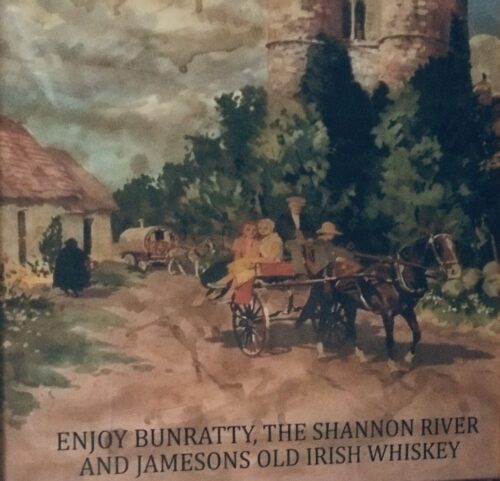
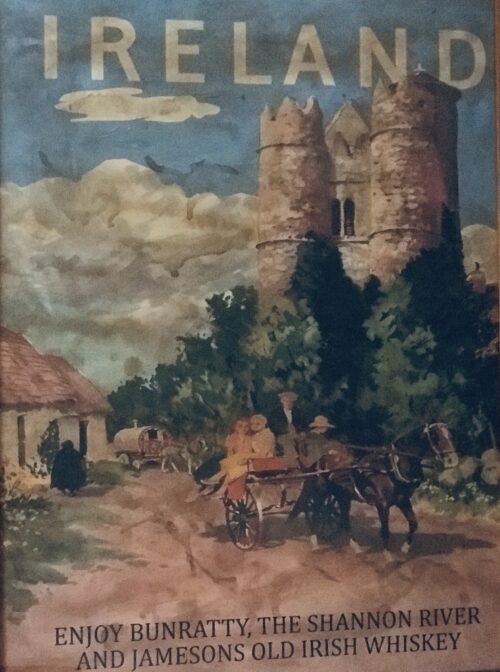

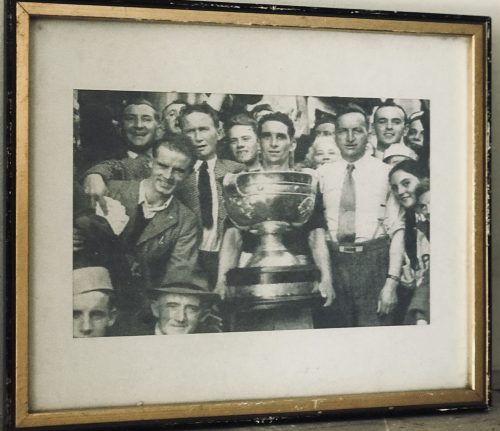
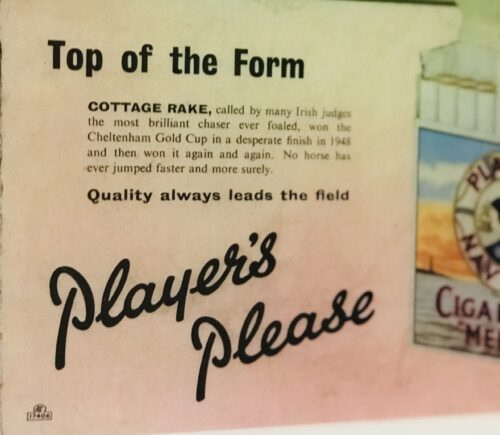
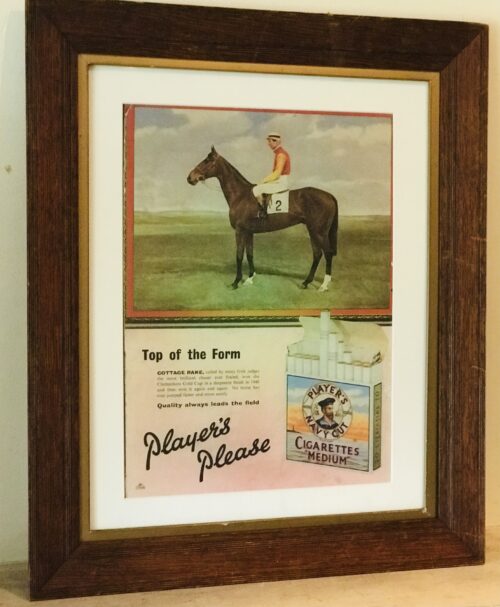
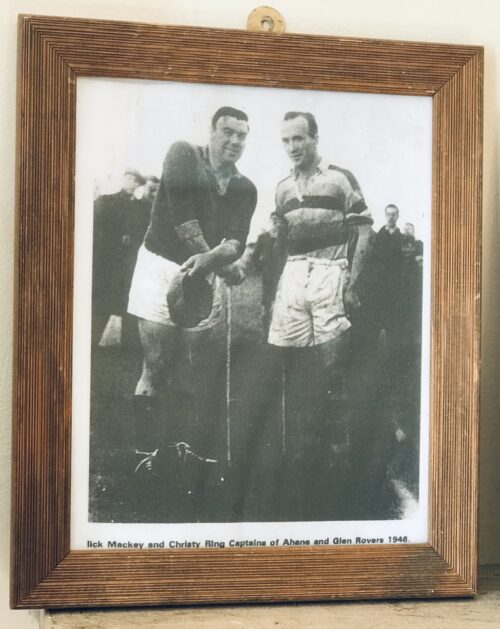
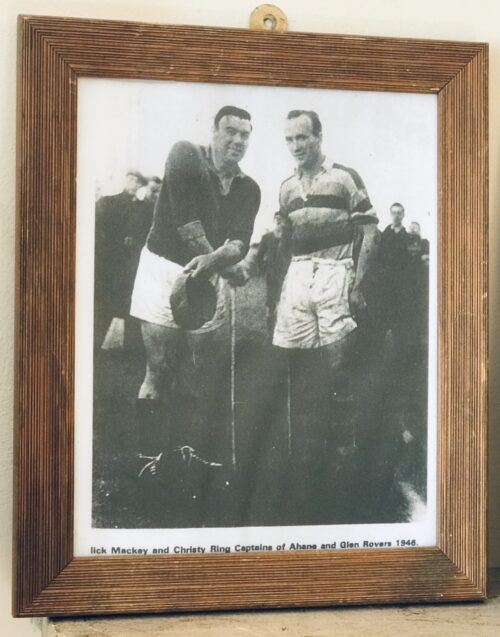
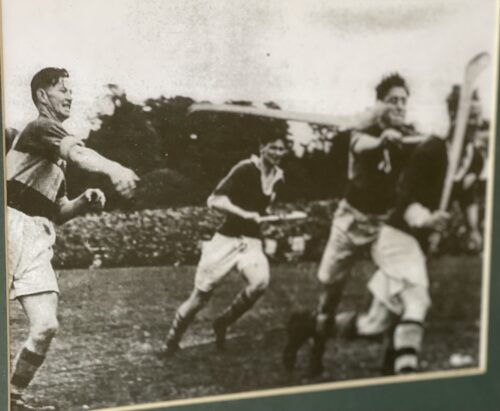
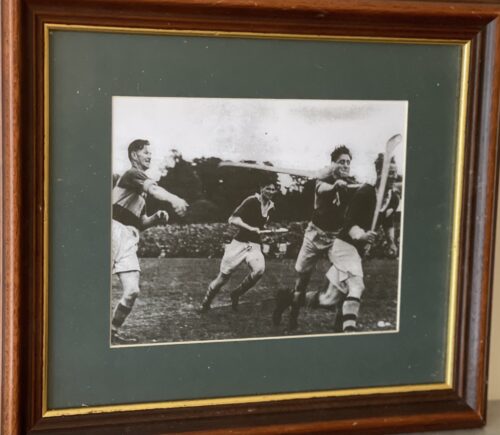

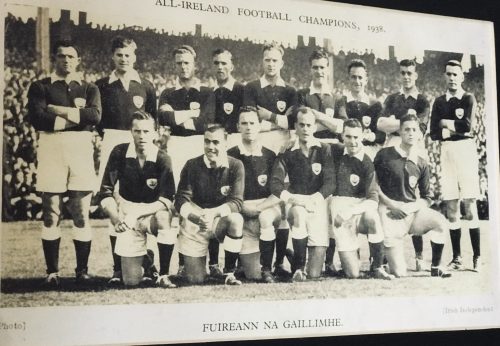
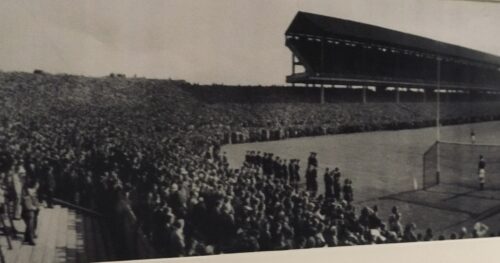
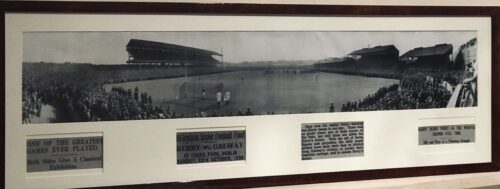



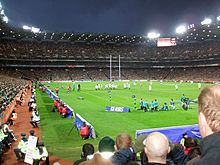
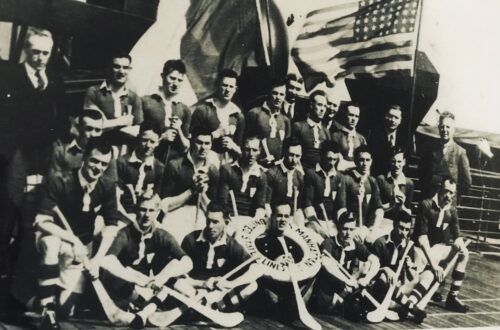
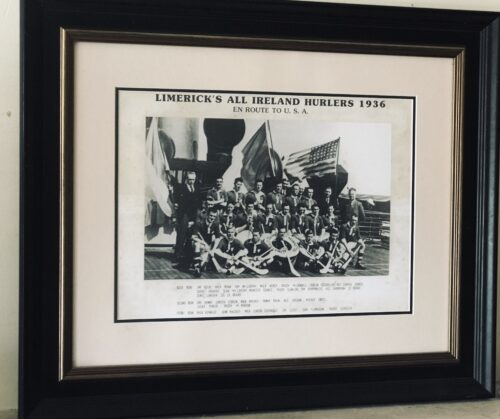
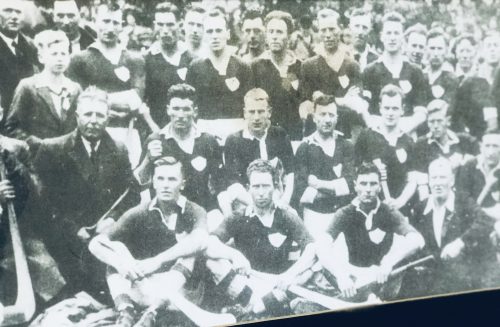
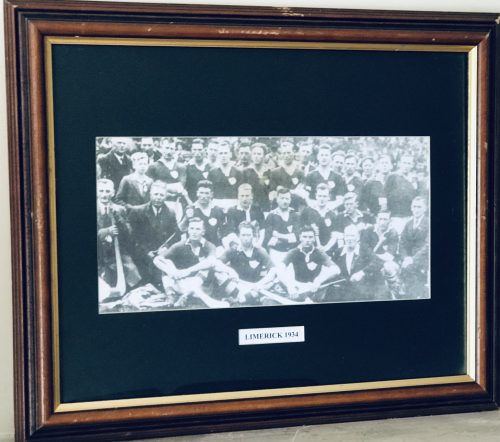
 Limerick 5-2 Dublin 2-6
D Clohessy 4-0, M Mackey 1-1, J O’Connell 0-1
Limerick 5-2 Dublin 2-6
D Clohessy 4-0, M Mackey 1-1, J O’Connell 0-1



